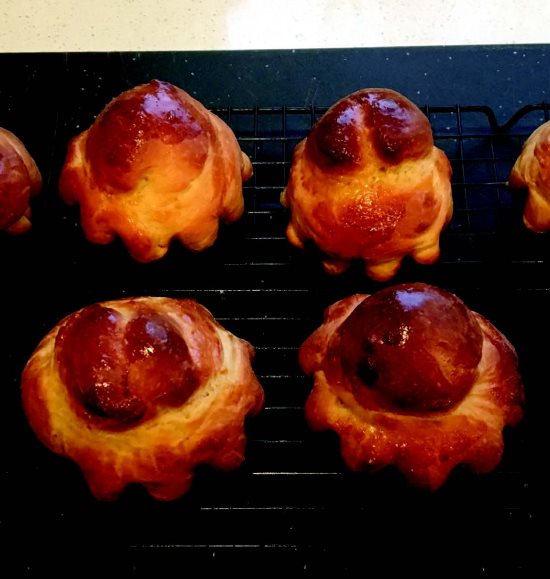|
|
Published March 22nd, 2017
|
This beautiful brioche is shaping up to be a great alternative to regular bread
|
|
| By Susie Iventosch |
 |
| This brioche beckons cooks. Photo Susie Iventosch |
We were out for lunch about a month ago and right next door there was a tempting bakery. It was beckoning all during lunch, so after we finished our meal, we dipped into the bakery to see what kinds of goodies they had on hand. The shelves were rather bare, and all they had left were a few loaves of bread and four brioches. Okay then, "We'll take four brioches, please!" (The "s" is silent, so singular [brioche] and plural [brioches] are pronounced exactly the same.)
 Since we were planning on burgers that night, I thought it would be a great idea to use these beautiful brioches as buns, and they were fantastic! It didn't take long for me to decide that I should try making my own brioches, and have since made four batches.
Since we were planning on burgers that night, I thought it would be a great idea to use these beautiful brioches as buns, and they were fantastic! It didn't take long for me to decide that I should try making my own brioches, and have since made four batches.
 The dough is really quite easy to make and the baked brioches keep very well in the refrigerator, but the tricky part is shaping them before baking. In most brioche recipes, there is reference to the "têe," which simply means "head" in French. If you've seen traditional brioches, they look like a two-part snowman, with a larger ruffled body and a much smaller round "head." There are two processes for shaping the brioche like this, and I have a video link below to show you the two methods. In both cases, you use the side of your hand to divide the dough into two unequal parts, but still connected by a little "neck" or thin piece. Of the two, I prefer the one where you just twist the neck a little bit and rest the head on top, as compared to making a hole in the body and slipping the head through from the bottom. Don't worry, you'll see what I mean after watching the video!
The dough is really quite easy to make and the baked brioches keep very well in the refrigerator, but the tricky part is shaping them before baking. In most brioche recipes, there is reference to the "têe," which simply means "head" in French. If you've seen traditional brioches, they look like a two-part snowman, with a larger ruffled body and a much smaller round "head." There are two processes for shaping the brioche like this, and I have a video link below to show you the two methods. In both cases, you use the side of your hand to divide the dough into two unequal parts, but still connected by a little "neck" or thin piece. Of the two, I prefer the one where you just twist the neck a little bit and rest the head on top, as compared to making a hole in the body and slipping the head through from the bottom. Don't worry, you'll see what I mean after watching the video!
 Whichever method you choose, they ultimately end up looking pretty much the same. These little treats are delightful and just the perfect size for a breakfast snack or a dinner roll. When toasted, they are absolutely divine with peanut butter and jam. If you should want to use them as burger buns, I would suggest making them a little bit larger, and making only 12 brioches from this batch versus the 16 called for in the recipe.
Whichever method you choose, they ultimately end up looking pretty much the same. These little treats are delightful and just the perfect size for a breakfast snack or a dinner roll. When toasted, they are absolutely divine with peanut butter and jam. If you should want to use them as burger buns, I would suggest making them a little bit larger, and making only 12 brioches from this batch versus the 16 called for in the recipe.
 Have fun and don't be afraid. You, too, can be a brioche baker!
Have fun and don't be afraid. You, too, can be a brioche baker!
 Here is the link to the "Shaping Brioche" video: https://www.youtube.com/watch?v=U_yLixXub-E
Here is the link to the "Shaping Brioche" video: https://www.youtube.com/watch?v=U_yLixXub-E
 Cooking Term of the Week
Cooking Term of the Week
 Bench Proof
Bench Proof
 Bench proofing (or bench resting) refers to the intermediate rising where you punch the dough down and allow it to rest between the first rising where the yeast grows and allows the dough to leaven, and the final rising after you've shaped the dough and placed it in the pan to rise (proof) before baking. Bench proofing can last anywhere from 10 minutes to a couple of hours, depending upon what you are making.
Bench proofing (or bench resting) refers to the intermediate rising where you punch the dough down and allow it to rest between the first rising where the yeast grows and allows the dough to leaven, and the final rising after you've shaped the dough and placed it in the pan to rise (proof) before baking. Bench proofing can last anywhere from 10 minutes to a couple of hours, depending upon what you are making.

|
|
|
|
|
|
|
|
|
|
|
|
|
|



